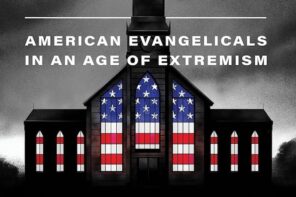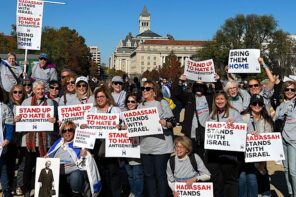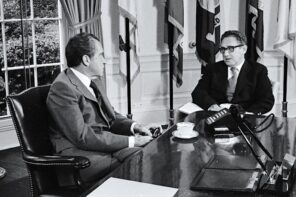Are the Jews an ethnic or religious group? The answers to this question, shifting from one historical age to another, are a barometer of the changing identity of this people. The widely preferred contemporary self-identification is “American Jews,” which, like American Catholics, suggests a religious identity, although it may equally signal the priority of the Jewish over the American. “Jewish Americans,” while superficially equivalent to “Italian Americans,” has never enjoyed the same usage. In titling their PBS documentary The Jewish Americans, these filmmakers have therefore made a telling statement. After three and a half centuries of struggling to become American, the Jews have finally come “home” (incidentally, the title of part three of the documentary). Like the Hispanics, Irish and Italians, they, too, have become an ethnic species of the American genus.
To be sure, The Jewish Americansdoes not ignore the religious dimension of Jewish identity. The first Jewish settlers in North America, Sephardim who came from Brazil in 1654 in search of religious freedom, set the stage for later immigrations. They built their first synagogue so as not to attract attention to themselves, thus seeking a private sphere in which to preserve their religion. It was in recognition of this right to free worship that George Washington wrote his famous 1790 letter to the Rhode Island Jews after visiting their synagogue in Newport, declaring eloquently that the United States would “give to bigotry no sanction, to persecution no assistance.” Intermarriage, which came to be seen as a demographic threat in the late twentieth century, was originally resisted on religious grounds as a violation of Mosaic law.
Religious experimentation has been one of the driving characteristics of American Jewish history. Although Reform Judaism started in Germany, it developed its own distinct manifestations in America. Conservative Judaism and Mordecai Kaplan’s Reconstructionismare also both singularly American. Even Orthodoxy evolved as it developed in America. Thus, Lubavitch or Chabad Hasidism assumed its unique missionary role after taking up residence in the Crown Heights neighborhood of Brooklyn, New York. The Jewish Americansconcludes aptly by examining some of the more recent manifestations of this experimentation, including New Age and Jewish-Buddhist hybrids. As Rabbi Harold Schulweis expresses: “It used to be a Jew went to synagogue because that’s what a Jew did. Today, a Jew goes to synagogue to learn how to be a Jew.”
This religiously-oriented narrative underwent a dramatic change, starting in the 1880s, with the mass immigration of over two million Eastern European Jews to America. The documentary attributes this wave of immigration that lasted until1924 (when quotas cut it off) to political persecution by czarist Russia. This is an oversimplification since just as important, if not more, was the simultaneous demographic explosion of the Jewish population in the Russian “Pale of Settlement” and economic impoverishment, especially when a crash program of industrialization in the 1890s starved the Russian countryside.
Whatever the cause, Russian Jews who flocked en masse to America abandoned their religious practices in much greater numbers than had their German and Sephardic predecessors. They came largely without their Old World rabbis and were willing to compromise religious laws in order to make it in America. This process of secularization is alluded to, though inadequately examined—despite being a major factor in the emergence of new forms of political and cultural Jewish identity. The documentary does an excellent job of presenting the catastrophic Triangle Shirtwaist Factory fire of 1911 in which 146 workers, mostly Jewish and mostly female, lost their lives. This event catalyzed the movements toward safer working conditions and unionization, led in large numbers by Jewish workers and organizers. It was this crucible of working-class life that shaped not only the political consciousness of the immigrant Jews, but also their descendants down to the present day (contemporary Jews are said to have the wallets of Episcopalians, but to vote like African Americans). The documentary also gives due attention to the Yiddish culture that flourished in newspapers and theaters that became the medium for progressive politics.
Anti-Semitism has been a recurrent theme in the history of Jewish Americans; perhaps the most shocking example of which was the lynching of Leo Frank in 1915 in Georgia. In the interwar years, American nativism closed the doors to immigration and led to increased anti-Semitism, including quotas at many elite universities. The Jewish Americans tells the story of Henry Ford’s Dearborn Independent, which recycled the Protocols of the Elders of Zion and generally promoted a vicious form of anti-Semitism. But Ford got his comeuppance when a Jewish labor lawyer in California sued him for libel; Ford collapsed in the face of this challenge, and issued an abject apology rather than taking the stand in his own defense. This incident deserved greater analysis, since it suggests the limits of anti-Semitism in the American context.
Substantial attention is paid to the role of Jewish soldiers in World War II, a solid editorial decision. The mass mobilization of Jews for the war effort played a major part in diminishing anti-Semitism by bringing many non-Jews face to face for the first time with their Jewish fellow citizens. Whether this was the only factor in the precipitous change in public opinion from widespread anti-Semitism before the war to nearly universal acceptance after the 1960s seems unlikely, though many other possibilities remain unarticulated.
One factor that The Jewish Americans does explore in depth, though without relating it to the drop in anti-Semitism, was the mass movement of Jews to the suburbs in the post-World War II era. It was no doubt there, after leaving the immigrant ghetto, that they developed the same kind of personal relations that Jewish servicemen had developed in the army with non-Jews. It was also in the suburbs that the Jews turned increasingly to religion as their primary mode of identification and to synagogues as the primary institution for giving it expression.
The move to the suburbs coincided with the rise of the Jews out of the working class and into the middle class, a process that typically took one to two generations after immigration. In recent decades Jewish prosperity has grown even more, a theme that the documentary, perhaps out of fear of stirring latent anti-Semitism, does not really investigate. But it is worth doing so. Why were the Jews able to make it in America so successfully, outstripping every other immigrant group in terms of wealth and occupation? Was it, as historian Yuri Slezkine has argued, because they already possessed the characteristics of modernity such as literacy, mobility, and secularity? Was it their urban experience in Europe, an experience far different from that of Italian, Polish, or Irish peasant immigrants? Did it have something to do with the timing of their immigration and their specific professions? All of these were probably the case, but the documentary is more interested in telling the story than in analyzing its causes.
Had it done so, it would have had to investigate in much greater detail the European background of the Jewish Americans. This is perhaps where the documentary is weakest. All of the developments one finds in the immigrant generations (socialism, unionism, Yiddishism, urbanism) can be found in Europe as well. The American story, unique in some ways as it is, is not entirely unique and should be painted against the larger backdrop. Jews around the world, whether in Israel, the former Soviet Union, Europe, Latin America, or North America, have all ended up with a similar cultural, political, and economic profile, regardless of the particular history of the host country. In other words, socialist Zionist Israel, Communist Russia, and capitalist America all produced by the late twentieth century technologically advanced, highly urbanized, largely secular Jews (there are obvious exceptions, especially to the last category). This convergence demands an explanation, but because The Jewish Americans is so insistent on the uniqueness of its subject it fails to even address the question.
The story the documentary tells is a largely harmonious and triumphalist one. Despite the anti-Semitism it documents, the Jews themselves remained largely united and determined to preserve their identity. The rougher edges of the story often remain out of sight. Thus, although the film mentions that the owners of the Triangle Shirtwaist Factory were Jewish, the intense class struggle between Jewish bosses and workers gets less treatment than it deserves. Only with the Julius and Ethel Rosenberg case are the fissures in the Jewish community between communists and anti-communists really investigated. In that case, not only the defendants, but also the judge and prosecutors were Jewish. The non-Jewish jury was treated to an intra-Jewish fight, albeit one not explicitly articulated. What is missing is a voice on the side of the Rosenbergs. The historian talking-heads tell us that Julius was guilty, but Ethel perhaps not. This is, in fact, the state of the evidence right now, but it would have been good to hear from someone other than Jules Feiffer quoting his communist sister (maybe from the sister herself?); in other words, from someone who actually embraced the cause.
Similarly, the documentary recognizes that the primary conflict in the Jewish community today is over the state of Israel. But all of those interviewed seem to conclude that Jewish Americans do not want to endanger Israel’s survival by taking their disagreements public. Playwright and interviewee Tony Kushner has been quite public in his criticism of Israeli policies, but you would never know that from watching The Jewish Americans.
On the other hand, the excellent treatment of Jewish participation in the Civil Rights Movement points out that Southern Jews were very reluctant to support the Northern Jewish Freedom Riders. Their history in the South dictated a low profile, or so they felt. Here was a real split among Jewish Americans.
For a documentary that covers three hundred fifty years, there are inevitable lacunae. While the editors have made admirable choices on the whole, there are some glaring omissions. Where, for instance, is Emma Lazarus, the Sephardic poet whose verse adorns the Statue of Liberty? We are also surprised that perhaps the most iconic Jewish moment from the Civil Rights Movement, the picture of Abraham Joshua Heschel marching with Martin Luther King, does not appear. Heschel, who is sadly absent from the documentary, said of that moment: “I felt like my feet were praying.” Here was the quintessential expression of the American Jewish marriage between spirituality and social justice and it’s nowhere to be found. Finally, although attentive to the diversity of Sephardic, German, and Eastern European Jews, as well as African-American Jews, the documentary does not adequately explore recent additions to the American Jewish community, notably from Russia and Israel.
These criticisms notwithstanding, The Jewish Americans is a compelling celebration of what may be America’s most successful ethnic and religious minority. The filmmakers have gathered remarkable visual materials, including compelling home movies, to tell their story. Some of it involves well-known figures, such as Hank Greenberg (the subject of a recent documentary of his own); while others are less known, such as Anna Solomon, born in Posen, Poland, who moved in the late nineteenth century with her husband to Arizona via Pennsylvania. There she raised a family in desolate conditions, managing somehow to preserve a Jewish life where there were hardly any Jews. In tales such as these, The Jewish Americans weaves a complex account of an identity at once ethnic and religious; an identity in such constant and dynamic flux such that its remains thoroughly unpredictable.




